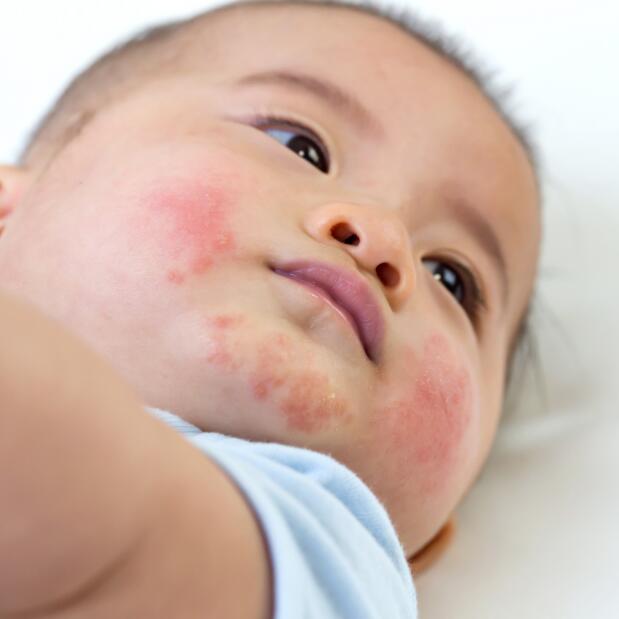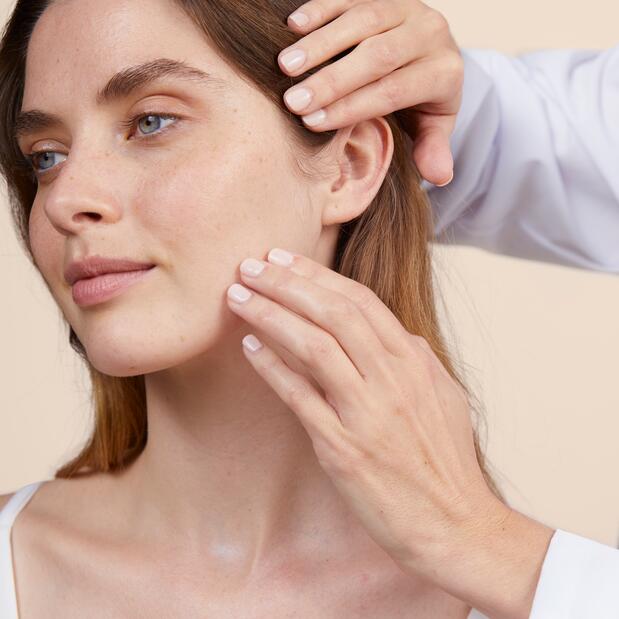Infant eczema
Infant eczema
Is your little one's skin dry and dotted with red patches on the face, arms and legs? Are they scratching, squirming and having trouble sleeping? Perhaps they are suffering from infant eczema. Although this common condition usually disappears in infancy, your baby still needs relief.

Infant eczema: recognising, understanding, relieving
Your baby is grumpy, sleeps badly, rubs against their sheets, wriggles... Infant eczema appears a few weeks after birth. The forehead, cheeks and chin are the most predisposed areas, but red patches can occur on other parts of the body. Fortunately, the area under the diaper is generally spared.
Then this type of eczema settles in the folds: elbows, knees, wrists... Infant eczema affects about two out of ten children and includes a hereditary factor. It usually heals spontaneously during infancy, but your baby still needs to be relieved and pampered during and between flare-ups.
When I see him scratching, I really want to help and relieve him. We’ve all decided to fight this together so that he can grow up properly.
Cécile, Théo's mother
Infant eczema: is an allergy test necessary?
It’s not essential, because eczema is not strictly speaking an allergic disease. An examination by a general practitioner, dermatologist or paediatrician is sufficient to diagnose infant eczema.
However, it may be linked to an allergy to the cow's milk contained in infant formula. This hypothesis should be considered if the rash is present over a large part of the body or if your child suffers from digestive problems: he or she digests his or her milk poorly and does not gain weight. In this case, and only in this case, allergy tests will be carried out. Milk will be replaced in the event of a confirmed allergy to compensate for any nutritional deficiency.

Infant eczema: atopic dermatitis or contact eczema?
Both types of eczema can occur in children, but their origin, course and treatment are different.
Atopic eczema... ?
Atopic eczema in infants is due to a genetic predisposition of the skin, which does not play its role as a barrier against external aggressions. Atopic eczema in infants is not caused by a particular allergen but by the skin's high sensitivity to all allergens.
... or contact eczema?
Contact eczema generally appears later than atopic eczema in infants. It’s an allergic reaction to an allergen following contact with a product or object: soap, perfume, nickel, etc. The inflammatory reaction – the itchy red patches – is hyper-localised in this case.
In both cases, your child needs to be moisturised and relieved.
Learn all about contact eczemaOur moisturising and anti-itching advice
FRIENDLY (AND EXPERT) ADVICE
It’s possible to relieve baby's eczema, both during a flare-up and during a lull.
A flare-up of baby eczema is when red, itchy patches appear. For this period, which lasts a few days, the doctor will prescribe dermocorticoids, a cortisone-based treatment. Applied locally and following the doctor's recommendations, it significantly improves your little one's quality of life.
Outside of the flare-ups, their skin remains dry and fragile. It’s important to nourish and protect it with a suitable cream to keep it well hydrated. The daily application of an emollient helps to space out the baby's eczema attacks.

Best practices to relieve eczema in infants
The basic treatment for infant eczema is therefore the regular application of an emollient, ideally just after bathing.
After washing baby with a non-irritating product, dry them gently and warm the cream in your hands to soften it. Spread it by massaging the baby lightly, from the thigh to the ankle, from the shoulder to the wrist, from the chest to the stomach and from the back of the shoulders to the buttocks, without forgetting the face. Effectiveness and a tender moment together guaranteed!
Our solutions to relieve infant eczema
Eau Thermale Avène skin care products designed to soothe and nourish baby's skin.
- Avène Thermal Spring Water Spray
Thermal Spring Water
Avène Thermal Spring Water SpraySoothes - Restores the skin barrier - Calms
Which skin care routine should you adopt?
Identify what it really needs with the help of our experts and discover the most suitable skin care routine for you.

